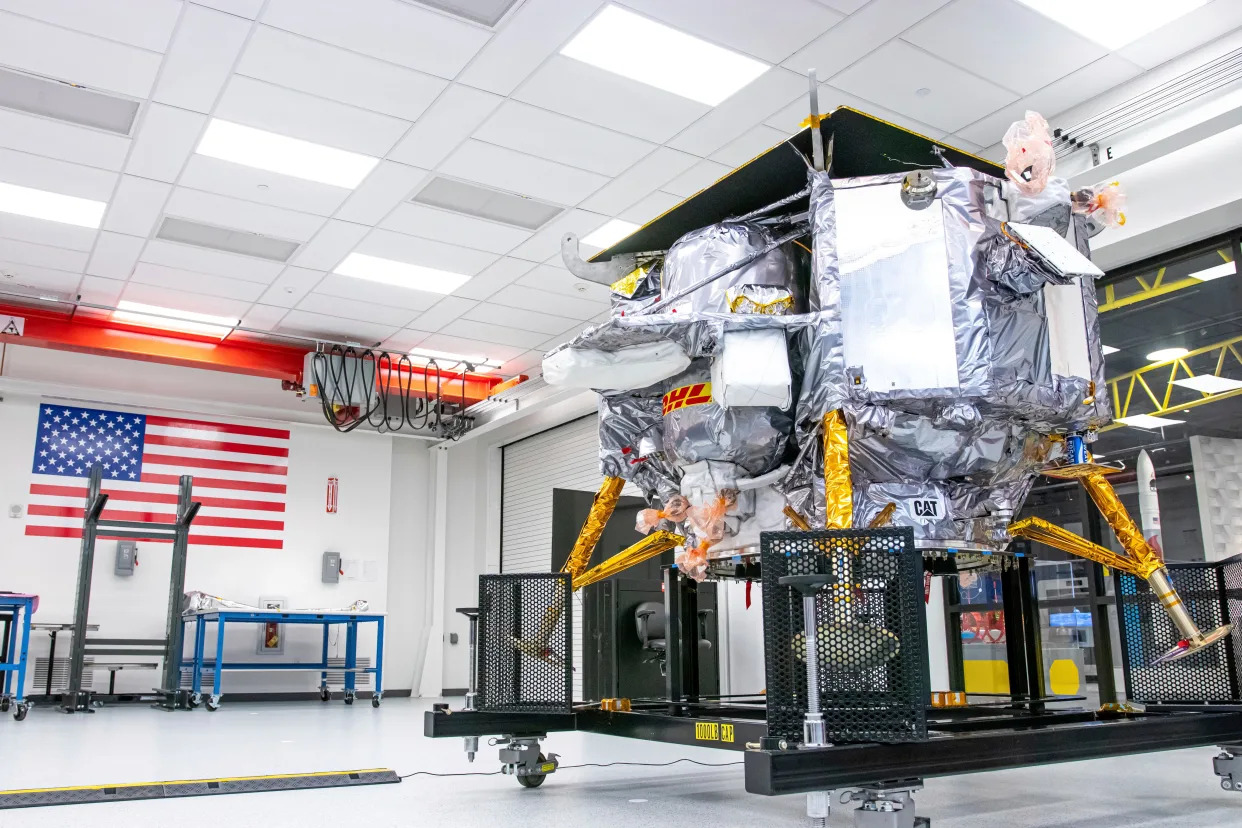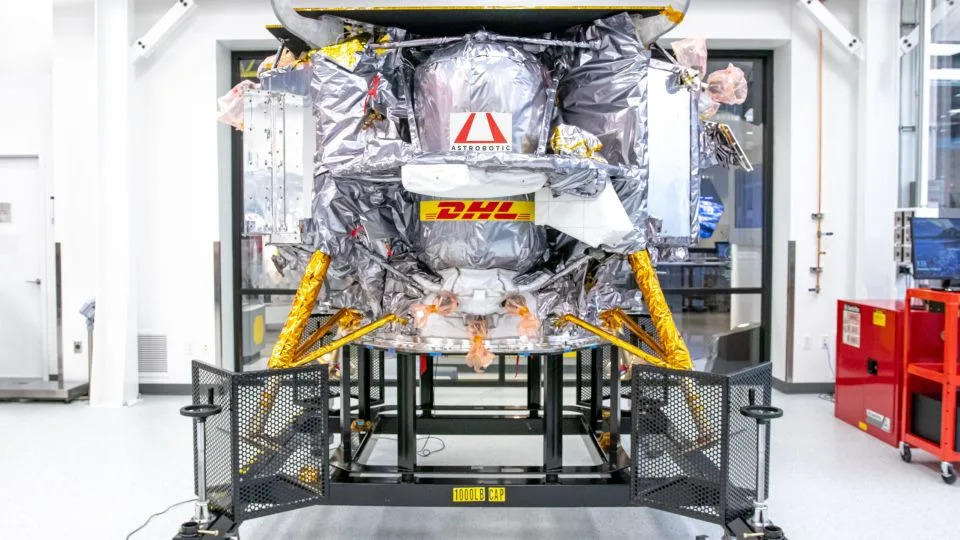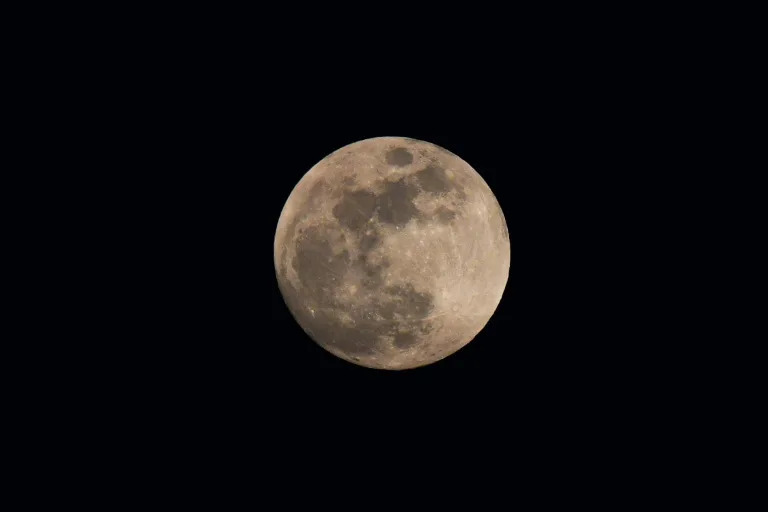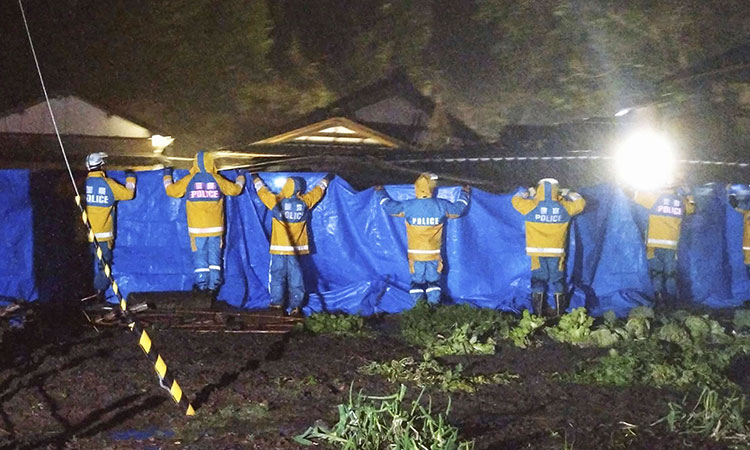Sarah Knapton
Thu, January 4, 2024

The US space company Astrobotic, is scheduled to lift off from Cape Canaveral in Florida next Monday, and will attempt to land on February 23
The first private mission to the Moon could touch down on the lunar surface next month, carrying British technology.
The US space company Astrobotic, is scheduled to lift off from Cape Canaveral in Florida next Monday, and will attempt to land on February 23.
If successful, it will be the first time a commercial company has made a soft landing on the Moon. The private Japanese firm iSpace attempted a landing last April, but crashed on the surface after misjudging its altitude.
Unlike previous Moon missions, which have been led by national space agencies, Peregrine Mission One (PM1) marks an historic change in space use, which could allow any private entity to reach the lunar surface.
Lander carrying payloads for Nasa
The lander is carrying payloads for Nasa, to help the agency prepare for humans returning to the Moon from 2025 under the Artemis mission.
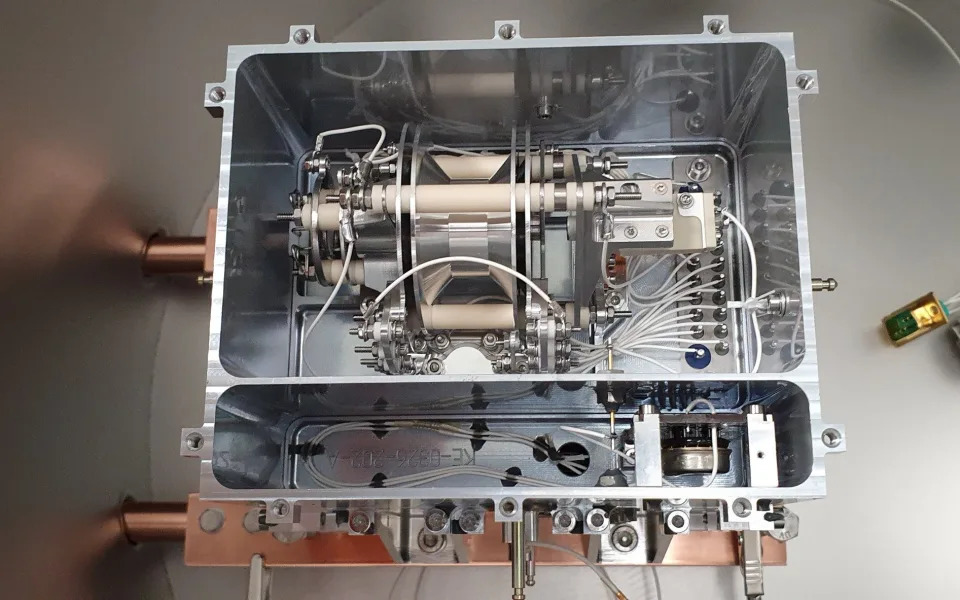
The British-made Ion Trap, pictured at the heart of the spectrometer after its integration to the rest of the instrument
Among its payload, the lander is carrying an instrument developed by British scientists which is hunting for water in the thin lunar atmosphere near to the surface, the first time technology from the UK has reached the Moon.
The Peregrine Ion Trap Mass Spectrometer (PITMS) - which is partly designed by The Open University and the Science and Technology Facilities Council RAL Space, will identify water molecules by measuring their mass as they pass through the sensor.
Pave way for future lunar pole missions
The instrument will pave the way for future missions to the lunar poles, where spotting water will be crucial to provide water for astronauts and future colonies. The mission is part of Nasa’s broader Artemis programme, which plans to return humans to the Moon in 2025.
Dr Simeon Barber of the Open University, said: “Various new data in the last decade has overturned the Apollo-era notion of the Moon as a bone-dry place.
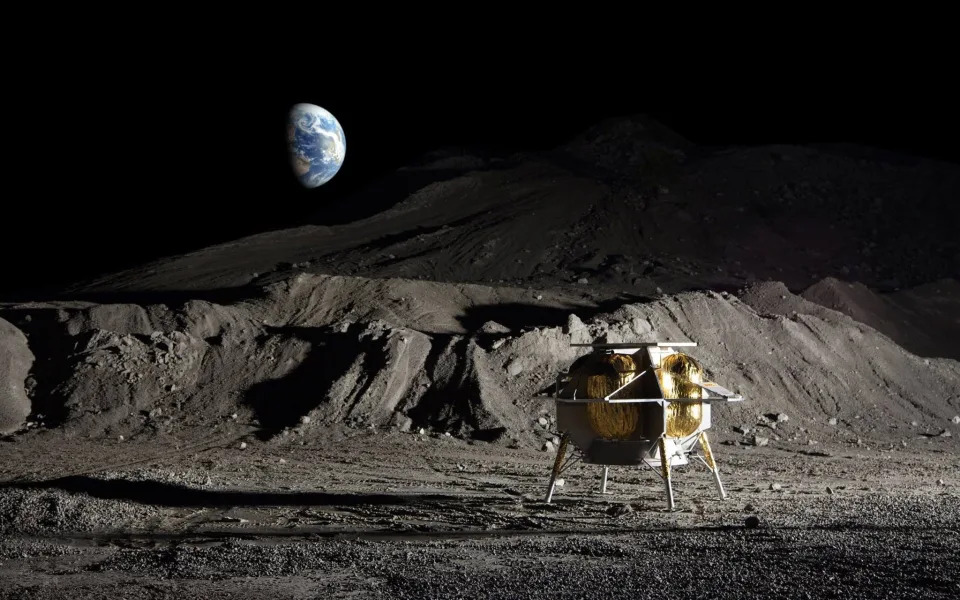
‘Various new data in the last decade has overturned the Apollo-era notion of the Moon as a bone-dry place.’
“We have seen hints of ice at the cold lunar poles, and suggestions of water globally, as well as new analyses of Apollo samples showing small pockets of water within the lunar rock itself.
“We are interested in how these water molecules travel through the lunar atmosphere under the influence of day-night temperature cycles, eventually reaching the super cold polar regions where they accumulate slowly as frost or ice layers.”
Destined for Gruithuisen Domes
The Peregrine lunar lander is destined for an area in the Gruithuisen Domes - a series of volcanic domes named after the German astronomer Franz von Gruithuisen.
Once it’s on the surface, the PITMS is designed to operate for roughly two weeks - or one lunar day.
Chris Howe, production and software group leader at STFC RAL Space, said: “The utilisation of the Moon’s water could prove vital for future human endeavours in space, so we’re incredibly proud to have had the opportunity to help develop PITMS and are delighted to see it safely on its way.
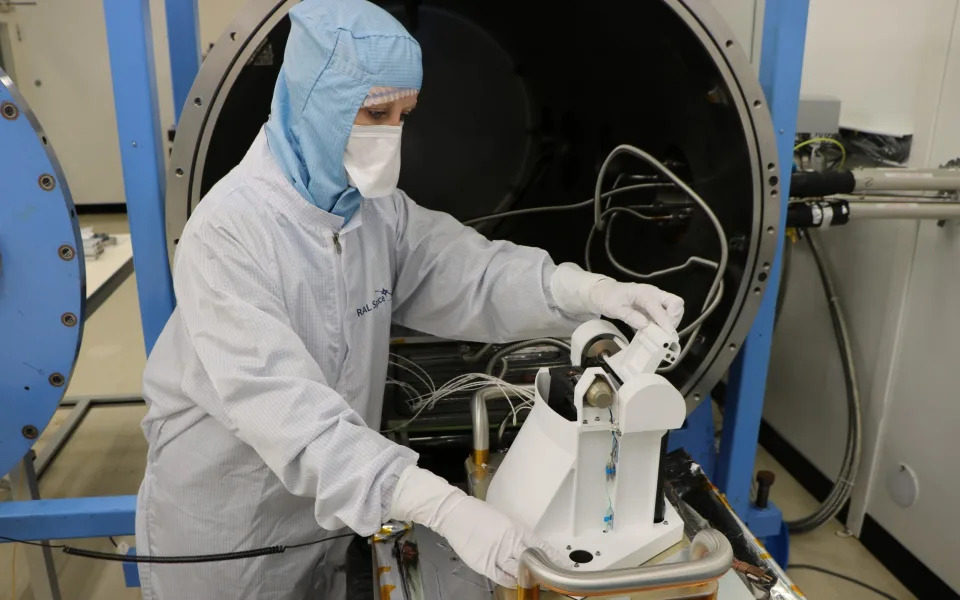
‘The technology from PITMS will now help underpin future missions so whilst PITMS will only operate for one lunar day on the Moon, its legacy will be felt for years.’
“The technology from PITMS will now help underpin future missions so whilst PITMS will only operate for one lunar day on the Moon, its legacy will be felt for years.”
The spacecraft will blast off aboard a Vulcan Centaur rocket, built by US aerospace manufacturer United Launch Alliance.
It is part of Nasa’s Commercial Lunar Payload Services (CLPS) initiative, which aims to involve commercial companies in the exploration of the moon. The Astrobotic lander is one of the first of at least eight CLPS deliveries planned by the space agency.
Other instruments search for hydrogen on Moon
Also on board is a Laser Retroreflector Array, which will act like a homing beacon from future missions, providing a permanent marker from which to make precise measurements for orbiting and landing spacecraft.
Other instruments will be searching for hydrogen in the Moon dust, or regolith on the surface, as well as looking for methane and carbon dioxide and monitoring radiation.
Libby Jackson, head of space exploration at the UK Space Agency - which provided £14 million in funding to develop the PITMS instrument through its European Space Agency membership, said: “Witnessing the first instrument from the UK, and indeed Europe, launch to the moon is a hugely exciting moment.
“We are looking forward to seeing Peregrine safely on the surface and the return of important data from PITMS to help unlock the secrets of water on the Moon.”
MARCIA DUNN
Thu, January 4, 2024




This illustration provided by Astrobotic Technology in 2024 depicts the Peregrine lunar lander on the surface of the moon. Its expected launch date is Monday, Jan. 8, 2024. (Astrobotic Technology via AP)
CAPE CANAVERAL, Fla. (AP) — China and India scored moon landings, while Russia, Japan and Israel ended up in the lunar trash heap.
Now two private companies are hustling to get the U.S. back in the game, more than five decades after the Apollo program ended.
It’s part of a NASA-supported effort to kick-start commercial moon deliveries, as the space agency focuses on getting astronauts back there.
“They’re scouts going to the moon ahead of us," said NASA Administrator Bill Nelson.
Pittsburgh's Astrobotic Technology is up first with a planned liftoff of a lander Monday aboard a brand new rocket, United Launch Alliance’s Vulcan. Houston's Intuitive Machines aims to launch a lander in mid-February, hopping a flight with SpaceX.
Then there's Japan, which will attempt to land in two weeks. The Japanese Space Agency’s lander with two toy-size rovers had a big head start, sharing a September launch with an X-ray telescope that stayed behind in orbit around Earth.
If successful, Japan will become the fifth country to pull off a lunar landing. Russia and the U.S. did it repeatedly in the 1960s and 70s. China has landed three times in the past decade — including on the moon’s far side — and is returning to the far side later this year to bring back lunar samples. And just last summer, India did it. Only the U.S. has put astronauts on the moon.
Landing without wrecking is no easy feat. There's hardly any atmosphere to slow spacecraft, and parachutes obviously won't work. That means a lander must descend using thrusters, while navigating past treacherous cliffs and craters.
A Japanese millionaire’s company, ispace, saw its lander smash into the moon last April, followed by Russia’s crash landing in August. India triumphed a few days later near the south polar region; it was the country’s second try after crashing in 2019. An Israeli nonprofit also slammed into the moon in 2019.
The United States has not attempted a moon landing since Apollo 17’s Gene Cernan and Harrison Schmitt, the last of 12 moonwalkers, explored the gray, dusty surface in December 1972. Mars beckoned and the moon receded in NASA's rearview mirror, as the space race between the U.S. and the Soviet Union came to a close. The U.S. followed with a handful or two of lunar satellites, but no controlled landers — until now.
Not only are Astrobotic and Intuitive Machines looking to end America’s moon-landing drought, they’re vying for bragging rights as the first private entity to land — gently — on the moon.
Despite its later start, Intuitive Machines has a faster, more direct shot and should land within a week of liftoff. It will take Astrobotic two weeks just to get to the moon and another month in lunar orbit, before a landing is attempted on Feb. 23.
If there are rocket delays, which already have stalled both missions, either company could wind up there first.
“It’s going to be a wild, wild ride,” promised Astrobotic’s chief executive John Thornton.
His counterpart at Intuitive Machines, Steve Altemus, said the space race is "more about the geopolitics, where China is going, where the rest of the world’s going.” That said, “We sure would like to be first.”
The two companies have been nose to nose since receiving nearly $80 million each in 2019 under a NASA program to develop lunar delivery services. Fourteen companies are now under contract by NASA.
Astrobotic’s four-legged, 6-foot-tall (1.9-meter-tall) lander, named Peregrine after the fastest bird, a falcon, will carry 20 research packages to the moon for seven countries, including five for NASA and a shoebox-sized rover for Carnegie Mellon University. Peregrine will aim for the mid-latitudes' Sinus Viscositatis, or Bay of Stickiness, named after the long-ago silica magma that formed the nearby Gruithuisen Domes.
Intuitive Machines’ six-legged, 14-foot-tall (4-meter-tall) lander, Nova-C, will target the moon’s south polar region, also carrying five experiments for NASA that will last about two weeks. The company is targeting 80 degrees south latitude for touchdown. That would be well within Antarctica on Earth, Altemus noted, and 10 degrees closer to the pole than India landed last summer.
Scientists believe the south pole’s permanently shadowed craters hold billions of pounds (kilograms) of frozen water that could be used for drinking and making rocket fuel. That’s why the first moonwalkers in NASA’s Artemis program — named after Apollo’s twin sister in Greek mythology — will land there. NASA still has 2025 on the books for that launch, but the General Accountability Office suspects it will be closer to 2027.
Astrobotic will head to the south pole on its second flight, carrying NASA’s water-seeking Viper rover. And Intuitive Machines will return there on its second mission, delivering an ice drill for NASA.
Landing near the moon’s south pole is particularly dicey.
“It’s so rocky and craggy and full of craters at the south pole and mountainous, that it’s very difficult to find a lighted region to touch down safely," Altemus said. "So you’ve got to be able to finesse that and just set it down right in the right spot.”
While Houston has long been associated with space, Pittsburgh is a newcomer. To commemorate the Steel City, Astrobotic’s lander will carry a Kennywood amusement park token, the winner of a public vote that beat out the Steelers’ Terrible Towel waved at football games, dirt from Moon Township’s Moon Park, and a Heinz pickle pin.
The lander is also carrying the ashes or DNA from 70 people, including “Star Trek” creator Gene Roddenberry and science fiction writer Arthur C. Clarke. Another 265 people will be represented on the rocket’s upper stage, which will circle the sun once separated from the lander. They include three original “Star Trek” cast members, as well as strands of hair from three U.S. presidents: George Washington, Dwight D. Eisenhower and John F. Kennedy.
___
The Associated Press Health and Science Department receives support from the Howard Hughes Medical Institute’s Science and Educational Media Group. The AP is solely responsible for all content.
Emilee Speck
Thu, January 4, 2024
The first American launch to the Moon's surface in decades will carry unique items that will remain on the lunar surface forever. Some items include human ashes, personal mementos, artwork and letters from children worldwide.
NASA, Astrobotic and United Launch Alliance are targeting Monday at 2:18 a.m. ET to launch the Vulcan rocket with Astrobotic's Peregrine Moon lander. It's the first mission for ULA's Vulcan rocket and potentially the first commercial Moon landing.
ASTROBOTIC AIMS FOR FIRST COMMERCIAL MOON LANDING WITH LAUNCH MONDAY CARRYING NASA SCIENCE
This is not a NASA mission; instead, the space agency is one customer of many on the first commercial American mission to the Moon. The robotic mission is carrying five NASA science payloads as part of NASA's Commercial Lunar Payload Services (CLPS) program. The Peregrine lander will also have a whole band of other science for customers, including Carnegie Mellon University, Mexico, Japan, Germany, the United Kingdom and Hungary.
But wait, there's more.
Astrobotic partnered with global shipping company DHL to sell space on the lander for people to send small items to the Moon.
"We've got folks that are sending inscriptions of family names, and sometimes there are photos of families," Astrobotic CEO John Thornton told FOX Weather in 2022. "We even have some pet hair from a family pet that passed. It's all sorts of different things that individuals like you and I can send up to the surface, and that's the very first time that is possible."
Astrobotic has its own payloads on Peregrine with a demonstration Terrain Relative Navigation sensor, and the company worked with Carnegie Mellon University staff and students to develop the tiny Iris Lunar Rover flying on Peregrine.
Five more small rovers will also launch on the mission. The Mexican Space Agency is sending miniature rovers about 12 cm across and weighing less than 60 grams for a demonstration mission on the lunar surface.
As a nod to its hometown, Astrobotic's lunar lander will also carry a token from local amusement park Kennywood. This item came down to a vote from Pittsburghers.
Space memorial companies Celestis and Elysium Space have also purchased space on the Peregrine lander. Friends and family can pay the companies to send their loved ones' ashes to the Moon, low-Earth orbit and deep space.
Celestis confirmed last year that ashes from the late ‘Star Trek’ actress Nichelle Nichols will be launching on the inaugural Vulcan rocket.
Arizona Public Radio first reported on Dec. 28 that Navajo Nation President Buu Nygren has asked NASA and the U.S. Department of Transportation to delay the launch because the Moon is part of the Navajo's spiritual heritage, and depositing human remains is "tantamount to desecration of this sacred space."
NASA Deputy Associate Administration for Exploration Joel Kearns said NASA received the letter from the Navajo Nation, and an intergovernmental team is looking into Nygren's request.
"We take concerns as expressed from the Navajo Nation very, very seriously," Kearns said. "And we think we're going to be continuing on this conversation."
LATE 'STAR TREK' ACTRESS NICHELLE NICHOLS TO GRACE ONE FINAL VOYAGE INTO THE COSMOS
NASA had previously been called to task by the Navajo Nation when the agency launched a memorial capsule on the Lunar Prospector mission in 1998.
A 1.75-inch capsule on the spacecraft contained the ashes of planetary geologist Eugene Shoemaker. The NASA mission ended after 18 years when the spacecraft crashed into the lunar surface.
Japanese company Astroscale purchased a ride on Peregrine for the Pocari Sweat Lunar Dream Capsule. The company said the time capsule shaped like the sports drink Pocari Sweat has 185,872 messages from children around the world.

A bus displays a commercial advertisement of the Japanese sports drink manufactured by Otsuka Pharmaceutical, Pocari Sweat, in Hong Kong.
Cryptocurrency will land on the lunar surface, too, as BTC Inc. is sending up a copy of the Genesis Block, the first block of Bitcoin to be mined.
2024 ROCKET LAUNCH SCHEDULE SHOWS CONTINUED STEADY PACE OF BLAST-OFFS
There are several art-related items launching to the Moon.
A group called "Writers on the Moon" purchased space on the DHL Moonbox, including work from 125 writers.
Another Carnegie Mellon payload includes MoonArk, a small museum on the Moon that "embodies arts, humanities, sciences and technologies in a set of intricately designed objects." Another art payload is the Lunar Mission One, a digital art gallery.
Still, none of these science payloads, words, digital art, ashes or personal items may make it to the lunar surface.
"The surface of the Moon holds many robotic spacecraft that were not able to land softly and complete the missions," NASA CLPS program manager Chris Culbert said on Thursday.
Over half of all lunar landings have been successful, and no private company has ever landed on the Moon. Thornton said in November that Astrobotic aims to be the first, and the mission carries "the hopes and dreams of Pittsburgh" along with all of its other customers.
How to Watch Vulcan Centaur's First Launch on Its Historic Moon Delivery Mission
Passant Rabie
Fri, January 5, 2024

The Vulcan Centaur rocket awaiting launch on the pad.
The Vulcan Centaur rocket awaiting launch on the pad.
Astrobotic’s Peregrine is gearing up for a chance to land on the Moon, hoping to become the first commercial lunar lander to touchdown on the dusty surface of the celestial body and pave the way for other private ventures to follow.
The lunar lander will ride on board United Launch Alliance’s Vulcan Centaur, which is scheduled for liftoff on Monday, January 8, at 2:18 a.m. ET from Cape Canaveral, Florida. The historic launch will be broadcast live on NASA Television, the NASA app, and the space agency’s website, and you can also tune in through the feed below. The live feed is set to begin at 1:30 a.m. ET.
Peregrine is scheduled for its lunar touchdown in late February, but landing on the Moon is no easy feat. So far, only NASA, Russia, and China have successfully landed on the Moon. Attempts by other nations have not ended well; Israel’s Beresheet crashed onto the Moon’s surface in April 2019, while India’s Vikram spacecraft did the same that September 2023. In April 2023, Japan’s ispace was also hoping to become the first private company to land on the Moon, but its Hakuto-R lander crashed on the surface.
The lander is aiming for a soft landing at the Moon’s Gruithuisen Domes—a cluster of volcanic formations in the Sinus Viscositatis region (meaning “Bay of Stickiness”).
For more spaceflight in your life, follow us on X (formerly Twitter) and bookmark Gizmodo’s dedicated Spaceflight page.
Chris Benson
Fri, January 5, 2024

A United Launch Alliance Vulcan Centaur rocket rolls out from the Vertical Integration Facility to Launch Complex 41 at Cape Canaveral Space Force Station in Florida on Friday. ULA will launch Vulcan Centaur on its maiden flight, carrying a number of payloads including the Astrobotic Peregrine lunar lander. Photo by Joe Marino/UPI
Jan. 5 (UPI) -- The goal of humans returning to the moon after more than 50 years will inch closer with the launch of the Peregrine Mission One planned for launch early Monday morning from at Cape Canaveral Space Force Station in Florida.
Liftoff aboard a United Launch Alliance Vulcan Centaur rocket -- its first flight -- is planned for 2:18 a.m. EST, capping a long wait because of delays that date to mid-2022.
Pittsburgh-based Astrobotic's Peregrine Mission One will mark the first U.S. lunar landing since the Apollo program's final 1972 flight.
The payload's scheduled moon landing in February will be adjacent to the largest dark spot on the near side of the moon at a site described as a "geologic enigma."
For registered virtual watchers of the launch, access will be granted to resources like schedule changes and mission-specific information, as well as a commemorative stamp for a virtual guest passport.
The Vulcan rocket is to make its first flight, carrying the Peregrine commercial lunar lander for Astrobotic. The Peregrine robotic lander, which will carry experiments, scientific instruments and other payloads, also will carry two prototype satellites for Amazon's Kuiper broadband constellation.
Part of NASA's Commercial Lunar Payload Services Initiative, Peregrine Mission One is described as a "commercial robotic lunar delivery service" that will bring needed components to help humans sustain life in space.
Observers consider this a a crucial step in the Artemis moon program, in which the 10-day Artemis II mission planned for late this year will bring humans the farthest from Earth any astronaut has been.
NASA is looking to land astronauts on the moon in the Artemis III mission, which the space agency predicts will happen before the end of 2025. But that depends on a lot of contractors, including SpaceX, and space observers have said that date might be too optimistic.
One of 14 NASA providers under contract able to bid on task orders, so far only nine task orders have been granted to five providers -- Astrobotic included -- set to deliver over 40 loads to the moon's surface until 2025.
The chosen delivery providers are responsible for their own launch, lander design and landing operations. Nine U.S.-based companies were selected in 2018 to be eligible vendors to bid on contracts, with five more added the next year.
"Robotic science investigations delivered to the moon ... will lay the foundation for a new era of solar system science to better understand planetary processes and evolution, to search for evidence of water and other resources, and support long-term, sustainable human exploration," NASA said.
Through November, commercial contracts through NASA have a combined value of $2.6 billion. ULA's Vulcan rocket production spanned five states -- Washington, Utah, Colorado, Alabama and Florida
Aria Alamalhodaei
Fri, January 5, 2024
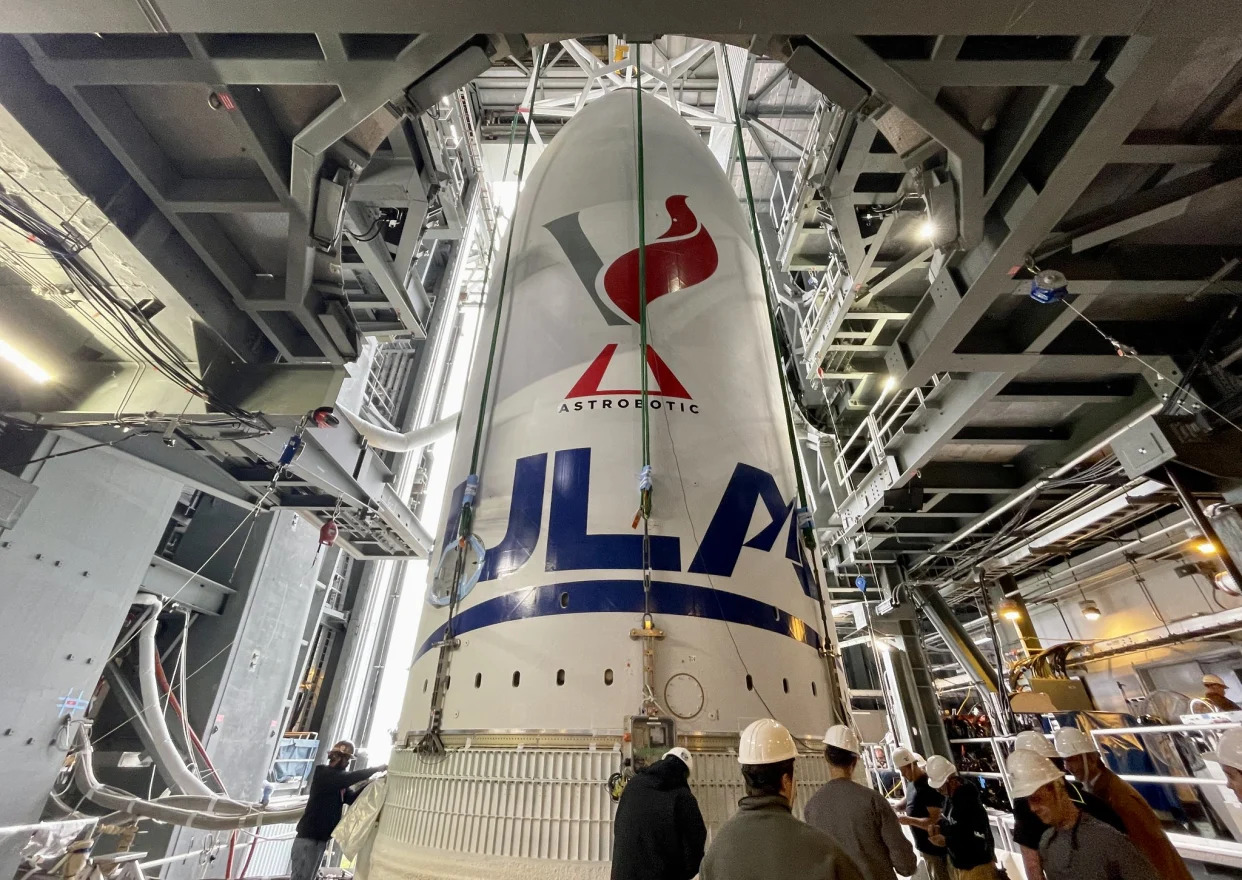
The countdown to launch is on. United Launch Alliance’s Vulcan Centaur rocket has been rolled to the launch pad at Cape Canaveral Space Force Station ahead of its early Monday morning launch, a mission that could end with the first fully private spacecraft landing on the moon.
Vulcan’s primary payload is Astrobotic’s Peregrine lunar lander. If all goes to plan, Peregrine will embark on a journey to the moon over the span of around 1.5 months, before attempting to land on the surface on February 23. The two companies had been targeting a Christmas Eve launch, but ULA decided to postpone due to ground system issues.
https://platform.twitter.com/widgets.js
“If you’ve been following the lunar industry, you understand landing on the Moon’s surface is incredibly difficult,” Astrobotic CEO John Thornton said in a press release last month. “With that said, our team has continuously surpassed expectations and demonstrated incredible ingenuity during flight reviews, spacecraft testing, and major hardware integrations. We are ready for launch, and for landing.”
ULA and Pittsburgh-based Astrobotic are not the only firms with much riding on Monday’s launch. This will also be the first time Blue Origin’s BE-4 rocket engines take flight on Vulcan’s first-stage booster (after years of delays), and the first mission as part of NASA’s program to kickstart payload delivery to the lunar surface.
That program, Commercial Lunar Payload Services (CLPS), has collectively doled out hundreds of millions to spur private development of moon landers. For this mission, Astrobotic was awarded $79.5 million from NASA in 2019.
The mission is slated to take off at 2:18 a.m. ET Monday. NASA will livestream the mission on its YouTube channel.
The launch will be the first of many heading to the moon this year. Other lunar launches slated for 2024 include Intuitive Machines IM-1 lander, which is scheduled for liftoff on a SpaceX Falcon 9 in February; Japanese firm ispace’s second lunar mission (their first lander crashed into the lunar surface shortly before touchdown); and Firefly Aerospace’s Blue Ghost lander in the third quarter of 2024. (Both Intuitive Machines’ and Firefly’s missions are part of the CLPS program.)
With such a lineup, it’s highly likely that 2024 will be the year that a private company lands a spacecraft on the moon for the first time, and the first time an American entity has gone to the lunar surface since 1972.
Astrobotic will attempt to land Peregrine near a region of the moon known as the Gruithuisen Domes, and it will be delivering a handful of NASA payloads and scientific instruments that will endeavor to better understand the lunar environment. Peregrine will also be delivering around 15 non-NASA payloads, including a rover from Carnegie Mellon University and a robotic project called Coleman from the Mexican Space Agency.
Private American Moon Mission Launching Monday
Sharon Adarlo
Fri, January 5, 2024
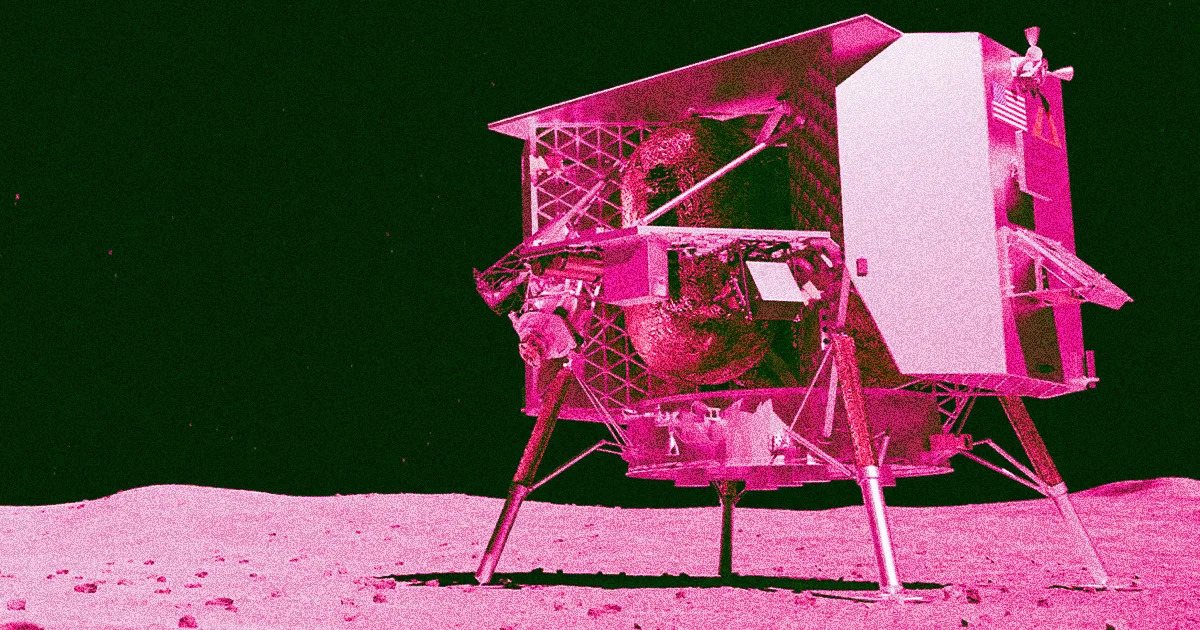
Moon Shot
NASA has been at the forefront of exploring the Moon since the days of the Apollo missions — but, curiously, hasn't sent a lander back to its surface since Apollo 17 in 1972.
But come Monday afternoon, if all goes well, the space agency will be headed back. This time, though, it'll be piggybacking on a commercial mission, according to The Guardian, a sign of the ever-growing links between NASA and the private space sector.
The lunar lander Peregrine, built by private space company Astrobotic, is the first venture from NASA's Commercial Lunar Payload Services program, The Guardian reports, in which the space agency essentially contracts with American businesses to ferry payloads to the lunar surface.
Peregrine's lunar ETA is February 23, and if successful will be the "first commercial robotic launch to the Moon’s surface," according to NASA. Another private space business, United Launch Alliance, built the Vulcan rocket launching the lunar lander into space.
In addition to some important NASA technology and scientific equipment, the lunar lander will have on board various sundries including a piece of Mount Everest, a physical bitcoin, and the human remains of Star Trek creator Gene Roddenberry, according to The Guardian.
Space Biz
There is some attendant controversy with this launch. Officials from the Navajo Nation objected to launching human remains at the Moon, calling it "tantamount to desecration."
NASA officials in response said they weren't responsible for what kind of stuff Astrobotic wants to bring along for the space ride.
This isn't the first controversy involving commercial space enterprise. NASA came under some scrutiny when critics lambasted SpaceX CEO Elon Musk's recent antisemitic remarks and reports of drug use at SpaceX.
Needless to say, expect more weird friction as NASA and the space business sector continue their awkward embrace in the years to come.
More on spacecraft: NASA Spacecraft Preparing to Attempt "Basically Landing" on the Sun
Swarming Robots, DNA, and Bitcoin: The Wild List of Stuff Heading to the Moon Next Week
George Dvorsky
Thu, January 4, 2024
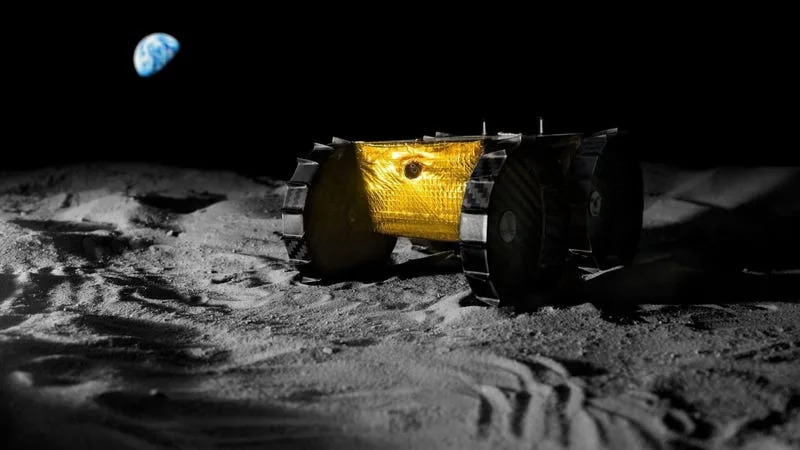
Conceptual image of the Iris rover, a student-built robot included in Astrobotic’s inaugural Peregrine mission.
Astrobotic’s Peregrine lunar lander is slated to blast off on Monday, January 8, carrying an assortment of goodies, including cutting-edge scientific rovers, bitcoin, and a piece of Mount Everest. No doubt, this ain’t your grandfather’s Moon mission, as the era of commercial space deliveries is now upon us.
The Moon will never be the same, thanks to a NASA-funded initiative meant to foster a new era of lunar exploration and enable private companies to deliver stuff to the lunar surface. This opens the door to a diverse range of non-scientific payloads, such as artworks, memorials, databanks, and a myriad of other imaginative items, effectively transforming the Moon into a new frontier for both scientific exploration and creative expression—for better or worse.
Delegating deliveries to the Moon
Peregrine is packed with payloads from both government and commercial partners. NASA’s Commercial Lunar Payload Services (CLPS) initiative, part of the Artemis program, collaborates with various U.S. companies to transport scientific and technological payloads to the Moon. These companies, tasked with responsibilities ranging from payload integration to lunar landing, are currently operating under contracts worth up to $2.6 billion through 2028. Astrobotic and Intuitive Machines (which is also planning to send a lander to the Moon in 2024) are set to launch lunar landers under NASA contracts worth $79.5 million and $77 million, respectively.
These collaborations are meant to support the space agency’s ongoing lunar exploration efforts and the preparation for future human missions to the Moon, and to do so affordably. Indeed, a key goal of Artemis is to make the Moon a sustainable place for long-term human presence and a springboard for future deep space exploration. CLPS is one of many initiatives that NASA has launched to foster commercial partnerships in space exploration, and with Astrobotic’s Peregrine Mission One (PM1), this vision is taking a major step forward.
Over 20 different payloads, including a diverse suite of scientific instruments, technologies, mementos, and other payloads from six different countries, dozens of science teams, and hundreds of individuals, are destined for the lunar surface, with a significant portion belonging to NASA. Though many have scientific purposes, others are distinctly non-scientific. But seeing as NASA helped to fund the mission, we’ll start with them.
NASA’s lunar goodie bag
The upcoming lunar mission, equipped with a diverse selection of scientific instruments belonging to NASA, is set to deepen our understanding of the Moon. The space agency’s Laser Retro-Reflector Array (LRA) will use laser beams to accurately measure the distance between the Moon and Earth, while its Linear Energy Transfer Spectrometer (LETS) will measure radiation at the lunar surface, enhancing astronaut safety during future missions.
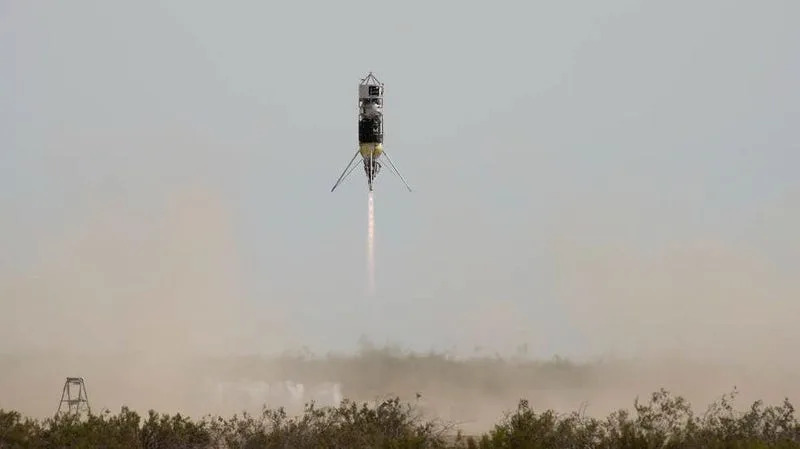
NASA’s Navigation Doppler Lidar (NDL) has been tested on Earth, as shown in this 2017 COBALT flight, but now it’ll be put to the test on the Moon.
The Near-Infrared Volatile Spectrometer System (NIRVSS) will analyze the lunar surface, identifying water and other substances. By examining lunar soil, the Peregrine Ion-Trap Mass Spectrometer (PITMS) aims to reveal the Moon’s composition, while the Navigation Doppler LIDAR (NDL) is designed to deliver accurate altitude, speed, and directional data to the guidance, navigation, and control subsystem, ensuring the safe landing of Astrobotic’s Peregrine lander on the Moon’s surface,” according to the space agency. Lastly, the Neutron Spectrometer System (NSS) will hunt for hydrogen to indicate potential water sources. Together, these tools mark a significant step in lunar exploration and potential habitation.
Other gadgets gathering on the Moon
Mexico and Germany are also sending scientific projects to our lone natural satellite. Mexico’s mission, its first to the Moon, is called Colmena, and it involves a swarm of five tiny robots that should self-assemble to form a single solar panel. The German-built M-42 radiation detector will measure and analyze the levels of cosmic radiation during its journey to the Moon and while on the surface, providing crucial data for assessing the safety and feasibility of future human lunar missions.

A detailed view of one of the five Mexican-built robots headed to the Moon.
The 5-pound Iris Lunar rover, developed at Carnegie Mellon University, is no larger than a shoebox, but once it gets rolling, it’ll become the first U.S. robot to work on the Moon. The rover’s job is to showcase its mobility, capture images for geological sciences, and use radio signals to assist with its localization. “Hundreds of students have poured thousands of hours into Iris,” Raewyn Duvall, commander of the Iris mission, said in a statement. “We’ve worked for years toward this mission…Iris will open up lunar and space exploration by proving that a tiny, lightweight rover built by students can succeed on the moon.”
Carnegie Mellon is also sending a time capsule to the Moon. Called MoonArk and weighing roughly 8 ounces, the four-chamber time capsule will carry a diverse collection of items, including hundreds of images, poems, music pieces, nano-scale objects, and samples from Earth. “It is designed to direct our attention from the Earth outward, into the cosmos and beyond, and reflects back to Earth as an endless dialogue that speaks to humanity’s context within the universe,” according to a university statement.

A partial view of MoonArk, detailing a segment of its four chambers.
Also aboard Peregrine is Arch Mission Foundation’s Library II, a disc packed with more than 60 million pages of information, including English Wikipedia, selected records from the Internet Archive, a linguistic key to 5,000 languages, and various private collections. The library is printed onto nickel NanoFiche, an “ultra-durable analog nano storage medium,” according to Astrobotic.
The DHL MoonBox contains more than two dozen capsules filled with various items, including photos, novels, student projects, and even a piece of Mount Everest. Hungary’s “Memory of Mankind (MoM) on the Moon” plaque contains archival imagery and text, but future Moon explorers will need a 10x magnifier to read it. Other items destined for the lunar surface include Astroscale Japan’s Lunar Dream Capsule containing messages etched onto titanium plates, and the Lunar Mission One digital art and music gallery.
Memorials on the Moon
Memorial spaceflight companies Elysium Space and Celestis are also participating in the Vulcan launch, sending the remains of deceased individuals to deep space and the lunar surface.

Space-bound capsules containing trace amounts of ashes.
Among those being memorialized are renowned science fiction writer Arthur C. Clarke, whose DNA is included in the Celestis payload, and several original Star Trek actors, along with the show’s creator, Gene Roddenberry (but their remains—trace amounts of ashes—will stay in space). Elysium Space’s Lunar Memorial service includes capsules containing the cremated ashes of individuals, offering families a unique, if perhaps indulgent, way to honor their loved ones.
We’re in the midst of preparing a full-fledged article on this aspect of the Peregrine mission, so stay tuned for that in the coming days.
Cryptoshenanigans
And for better or worse, the Moon mission will include some cryptocurrency-themed payloads courtesy of BitMex and Bitcoin Magazine. The BitMex project involves a physical Bitcoin etched with a private key, and it’ll remain on the lunar surface “awaiting retrieval by future explorers,” the crypto platform company says. The mission will also carry the Genesis Block’s text—the inaugural block in the Bitcoin blockchain—to the Moon. This tribute to cryptocurrency protocol will be displayed on a metal plate, presenting the block’s raw hexadecimal data, alongside a hologram of the Bitcoin Magazine logo.
So, we choose to go to the Moon, not just for scientific discovery and exploration, but also to drop off a bunch of cool and wacky stuff. It’s a new era, no doubt, one now limited only by the amount of tools, toys, and junk we can squeeze into a tiny lander


